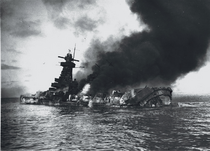Aestas War
| Aestas War | |||||||||
|---|---|---|---|---|---|---|---|---|---|
| |||||||||
| |||||||||
| Belligerents | |||||||||
|
Triple Alliance |
| ||||||||
| Commanders and leaders | |||||||||
|
|
| ||||||||
| Strength | |||||||||
|
|
| ||||||||
| Casualties and losses | |||||||||
|
| ||||||||
The Aestas War, also called the Suregni Islands War or Irassia War in the Suregni Islands and Irassia, respectively, was a war fought from 12 Feburary 1942 to 6 December 1943 over the Soltenish territories of the Suregni Islands and Irassia. Secessionist forces in Irassia and the Surgeni Islands were supported by Fresia, Antara, and Adrinian. It was the first of two conflicts over the territories in the 20th century.
Both the Irassian and Surgeni territories were, despite being Soltenish for over a century, considered different from most of Soltenia and strong secessionist movements and groups existed in the territories, rooted primarily in ethnicity and religion. Irassia, while speaking a Soltenish language, spoke Paletan, which was signifigantly different from most other Soltenish languages, while the Surgeni population was majority Adriños. Adrinian's leadership saw the protection of these Adriños as a major political imperative. Tensions had been high for several decades, with Soltenia funding and supporting communist movements throughout the region, angering the democracies in the region. The war began when the Triple Alliance, an anti-Soltenish alliance formed between Adrinian, Fresia, and Antara, recognized the Irassian and Suregni secessionist governments and moved naval units to force the Soltenish to abandon the islands.
In response to what Ricardo Conetti called an "infringement upon Soltenish sovereignty", Soltenia moved the bulk of its fleet to the Suregni Islands as well. Despite being outnumbered by the Triple Alliance task group, the Soltenish fleet under Admiral Cosimo Di Vierna was able to draw in the Triple Alliance forces close enough for Soltenia's land-based air to engage the Alliance fleet on 15 Feburary. While the Soltenish battleships Vierna and Orenza were sunk and the Giova was crippled, the Soltenish fleet inflicted heavy losses on the Alliance, including the sinking of the Fresian carrier Torch and Antaran battleship St. Azalae. In addition, much of the Soltenish fleet was able to escape and force the Alliance fleet to chase after it. This made the resulting naval invasion of Isla Grande more difficult, as the Alliance ground forces had to clear the island without much air or naval gunfire support. Alliance forces landed on Isla Grande on 23 February, and the island was considered cleared in August. Most of the Soltenish garrison was light infantry and aircrews equipped for coastal defense and the suppression of rebellions, making it less effective against the Alliance troops equipped for full scale combat. Just under half of the Soltenish garrison was killed or captured during the successful invasion. The Alliance forces proclaimed the Suregni Islands to be liberated, and established a provisional government.
The last major naval combat in the war was off the coast of Irassia, during the Battle of the Irassian Gulf. Despite hopes that superior numbers and technology would allow the Alliance to easily beat the weakened Soltenish fleet, the Soltenish were once again able to force combat within range of their land-based aircraft on 23 October. Despite this advantage, the Soltenish fleet was once again defeated, including the loss of the battleship Colpi. However, the ground campaign that began on 3 November was a disaster for the Alliance. Soltenish forces were much more prepared than in the Suregni Islands, having deployed multiple divisions of combat troops, including two divisions of Party Guards, and gaining air superiority in the region. Alliance forces were unable to penetrate deep into Irassia as planned and were fenced in along their beachheads. Combat operations in Irassia continued until January 31 1943, when the general order to evacuate was issued. This left Irassia in Soltenish hands, and the members of the Irassian secessionist movement were killed or captured by Soltenish forces by the end of March.
The remainder of the war was much less hectic. Despite plans for a renewed invasion of Irassia, Alliance forces could not maintain the naval supremacy necessary to take the territory, being vulnerable to Soltenish land-based aircraft. However, Soltenish forces could not compete with the Alliance navy and was forced to interdiction operations or to operate within range of land-based aircraft. Soltenish submarines during this period harrassed Alliance naval forces, sinking nine destroyers but at the cost of six submarines. After several months of this low-intensity conflict, both sides agreed to a truce in September 1943.
The Treaty of Seruf ended the war, effective 3 December 1943. The treaty ended the war with the status quo, leaving Irassia under Soltenish control but forcing Soltenia to recognize the Alliance-backed Republic of the Suregni Islands. Soltenia would reclaim the Suregni Islands in 1967 after a Soltenish-backed coup in the islands led to Vicente Rodriguez taking power and formally aligning his country with Soltenia. The islands would fully ascend to republic status in 1974, after the Soltenish Civil War.





